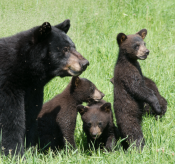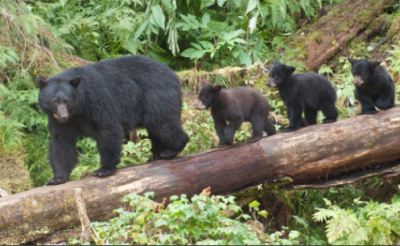What are Bears up to in July?:
What are Bears up to in July?: By July, cubs born this year have grown to the size of a raccoon or a small dog with big ears. Yearling bears now on their own can be the size of medium dogs. Bears of both sexes mark trees and adult bears mate. Cubs smell their mother’s breath to learn what’s good to eat. Bears’ great memories help them return to proven food sources.
By July, cubs born this year have grown to the size of a raccoon or a small dog with big ears. Yearling bears now on their own can be the size of medium dogs. Bears of both sexes mark trees and adult bears mate. Cubs smell their mother’s breath to learn what’s good to eat. Bears’ great memories help them return to proven food sources.
How to Tell the Difference Between a Cub and a Yearling? Yearling bears are about 18 months old in July and out on their own for the first time. Sometimes people mistake these young bears for abandoned cubs and think they need help.

Fun Fact: One way to distinguish yearlings is by their large ears. A yearling bear’s ears are as long as they will ever be, so as the bear gets older and bigger, the ears seem to shrink, but actually the bear’s head is getting larger and wider.
Cubs born this year are usually still with their moms; if they are left alone, they may cry and whimper. Yearlings seldom vocalize, but they do roam around looking for a home range of their own. Female yearlings are often allowed to share their mom’s home range, but males are forced to move out. It may be several years before male yearlings find a permanent home of their own.
Yearlings of both sexes are now trying to find food without their mom’s help. That’s why it’s so important to make sure there’s nothing around your place to attract them. They need to learn to find natural foods if they’re going to grow up wild.
Signs of Bear Activity: Bears often mark trees, especially in the summer mating season. Bears stand on their hind legs and scratch the trees with their claws and sometimes teeth. Both male and females mark trees. Many researchers believe bears create marker trees to announce they are in the area and let other bears know how big they are. Sometimes males will claw the tree above another male’s markings, as if to say, “I’m bigger than you are.” Bears often deliberately scratch aromatic trees such as conifers, cedars and cherry trees or creosote-soaked poles or structures because the scent created is stronger and carries further than the aroma the bear leaves behind.
Bears Are Still Looking for Mates: Mating often begins in June and goes on throughout July. Mature males may be more active in the daytime now as they travel longer distances throughout their home range. Female bears ready to mate also travel throughout their home range. Bears are very focused on finding mates, so try not to hike alone, pay attention and make noise if you’re out in the woods.
Large male bears chase off younger, smaller rivals but may do battle with other mature males for the right to mate. This is normal mating behavior; both bears may end up with wounds and scars, but even the loser is unlikely to be seriously injured. It’s not safe to approach or interfere. If you are lucky enough to spot two bears that clearly want to be together, just smile and give them some privacy.
Female bears can be ready to mate around age three but may be as old as eight (depending on food availability and conditions). Male bears are also mature at age three but usually must wait longer to mate because the youngsters can’t compete with big mature males.
Read more here at BearWise.org


